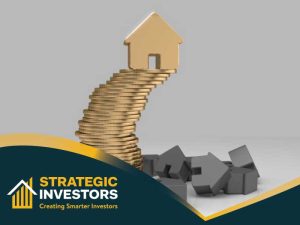
Are you sitting on unused property equity that could bolster your investment portfolio or support your financial aspirations?
Understanding and leveraging the equity you’ve built in your property can be a game-changer.
In this article, we’ll explore how property equity works, how you can calculate it, and the intelligent strategies to unlock its potential for maximizing your investments.
Key Takeaways
- Home equity increases over time as market value appreciates and mortgages are paid down, offering a platform for property investors to leverage for future investments.
- To calculate available equity for investment, subtract loan balance from 80% of the property’s market value and consider the Loan-to-Value ratio and bank valuations.
- Property investment using equity demands a tailored strategy, considering factors such as property selection based on location and market trends, structuring investment loans for tax benefits, balancing risks, and consulting professionals.
Understanding Property Equity: The Foundation of Investment
 Imagine this scenario: You own a property valued at $1 million, with a $500,000 outstanding balance on your investment loan. You subtract the amount you owe from the property’s value, and voila! You’ve got $500,000 in equity. But why does this matter? Well, if you’re a property investor, knowing how much equity you have could be your ticket to further investments and financial growth.
Imagine this scenario: You own a property valued at $1 million, with a $500,000 outstanding balance on your investment loan. You subtract the amount you owe from the property’s value, and voila! You’ve got $500,000 in equity. But why does this matter? Well, if you’re a property investor, knowing how much equity you have could be your ticket to further investments and financial growth.
Grasping the concept of equity not only provides insight into your property’s financial standing but also acts as a financial cushion during hard times. More importantly, it allows you to leverage your equity to buy an investment property using your existing property. Building equity could be what propels you from a one-property wonder to a flourishing property portfolio.
The Mechanics of Home Equity: How It Grows Over Time
 Home equity is a bit like a fine wine: it gets better over time. As your property appreciates in value and you pay down your home loan, your equity grows. But what factors contribute to this growth? It’s beneficial to explore the underlying mechanisms of home equity.
Home equity is a bit like a fine wine: it gets better over time. As your property appreciates in value and you pay down your home loan, your equity grows. But what factors contribute to this growth? It’s beneficial to explore the underlying mechanisms of home equity.
Appreciation and market factors are major determinants of your home’s value, and your mortgage payments directly affect how much you owe on your home loan. Both are instrumental in shaping your equity, but they work in different ways. We will examine this further.
Appreciation and Market Factors
Initially, property appreciation is a key point to discuss. As your property’s market value goes up, so does your equity. On average, homes in the U.S. appreciate by 2-3% per year. However, this rate can vary greatly depending on a host of market factors.
Some of the predominant factors that can influence your property’s appreciation include:
- Comparable home values
- The property’s age, size, and condition
- Neighborhood appeal
- The health of the overall housing market
- Interest rates
- Economic growth
Keeping an eye on these factors can help you anticipate changes in your home equity.
Mortgage Payments and Equity
On the other side of the equation, we have your home loan. Every mortgage payment you make reduces your loan balance, thereby increasing your equity. The portion of your payments that goes towards the principal loan amount directly contributes to building your equity.
But not all loans are created equal. The structure of your mortgage can significantly impact equity accumulation. For instance, making higher monthly payments can speed up the reduction of your principal loan amount, thus accelerating equity accumulation. Likewise, a larger down payment can immediately boost your home equity.
Calculating Your Available Equity: A Step-by-Step Guide
 Having familiarized ourselves with the fundamentals of home equity, it’s time to learn its calculation. The basic formula is quite simple: Equity = Property Value – Loan Balance. But when it comes to investing, there’s a bit more to it.
Having familiarized ourselves with the fundamentals of home equity, it’s time to learn its calculation. The basic formula is quite simple: Equity = Property Value – Loan Balance. But when it comes to investing, there’s a bit more to it.
To calculate your available equity for investment, follow these steps:
- Determine your property’s current market value.
- Subtract the remaining loan balance from the market value to find your total equity.
- Subtract the loan balance from 80% of the property’s value to determine the usable equity for investment.
But that’s not all. You also need to understand the Loan-to-Value ratio and the role of bank valuation.
Understanding Loan-to-Value Ratios
The Loan-to-Value ratio (LTV) is crucial in equity calculation. It’s the measure of the loan amount in relation to the market value of the property you’re using as collateral. LTV directly affects your available equity. Lenders prefer lower LTVs, which indicate more equity in the property and can result in more favorable interest rates.
However, a high LTV indicates a lower amount of equity in a property, making it more vulnerable to market changes and potentially increasing the risk of default for borrowers. Understanding LTV ratios can help you make informed decisions about leveraging your equity.
The Role of Bank Valuation
When it comes to assessing your equity, the value of your property is paramount. But who determines this value? Banks conduct their own valuations to assess your property’s worth and determine your loan amount or equity access.
Bank valuations are based on the following factors:
- Location
- Environmental factors
- Improvements
- Land size
- Market conditions
These factors are considered when conducting property valuation. A higher bank valuation can lead to an increase in the available home equity, while a low bank valuation can limit your borrowing capacity, affecting your ability to utilize the full equity in your home.
Tapping into Your Equity: Financing Options for Investors
 Once you’ve calculated your available equity, it’s time to put it to work. There are several financing options you can use to tap into your home equity, each offering unique benefits tailored to your specific requirements.
Once you’ve calculated your available equity, it’s time to put it to work. There are several financing options you can use to tap into your home equity, each offering unique benefits tailored to your specific requirements.
Whether you opt for a home equity loan, a home equity line of credit (HELOC), or refinancing, the choice depends on your individual goals, financial situation, and risk tolerance. For a more comprehensive understanding of these choices, we will examine each one in detail.
Equity Access Loan vs. Line of Credit
An Equity Access Loan offers the following benefits:
- Borrow against the equity in your home
- Receive a lump sum of funds
- Use the funds for property investments or other financial endeavors
- Fixed payments and a fixed interest rate
- Interest accrues on the entire loan amount from the start.
On the other hand, a Line of Credit offers:
- Flexible access to funds
- Ability to borrow or draw money multiple times from an available maximum amount
- Variable minimum payment amounts
- Variable interest rates
- Interest only accrues on the amount actually used.
Both options provide a way to tap into your home equity, but they vary in terms of flexibility and cost.
Refinancing for Investment
Another way to access your home equity is by refinancing your existing loan. Refinancing involves:
- Obtaining a new loan to replace your current one
- Often securing more favorable loan terms
- Accessing equity without having to pay Lenders Mortgage Insurance.
Refinancing for investment involves using the equity built up in your property by refinancing your existing home loan. This allows you to use the released equity as a deposit to purchase another investment property, thus expanding your investment capacity. However, it’s important to consider the additional costs associated with the refinancing process, which can affect the overall benefit of refinancing.
Strategic Use of Equity in Acquiring Investment Properties
 Armed with a solid understanding of equity and its potential, it’s now time to formulate a strategy. Leveraging home equity for property investment offers numerous advantages and can influence future borrowing capacity, enabling you to expand your property portfolio by utilizing the accumulated value in your current property.
Armed with a solid understanding of equity and its potential, it’s now time to formulate a strategy. Leveraging home equity for property investment offers numerous advantages and can influence future borrowing capacity, enabling you to expand your property portfolio by utilizing the accumulated value in your current property.
Strategizing involves deciding on the right investment property and structuring your investment loans for maximum benefit. It’s important to remember that every investment property and every investor is unique. Therefore, strategies must be tailored to align with individual goals and circumstances.
Deciding on the Right Investment Property
The selection of an appropriate investment property is key to optimizing equity utilization. Factors such as property type, current market values, and location desirability play a significant role in estimating potential equity growth. Market trends significantly impact the potential for equity growth, and understanding these trends is key to selecting a property that will maximize equity usage.
Location also plays a crucial role. Properties in sought-after areas near amenities, schools, and transportation hubs have a higher chance of attracting tenants and commanding higher rents. Consequently, this can contribute to enhancing the property’s value and equity potential.
Structuring Your Investment Loan for Maximum Benefit
Once you’ve decided on the right investment property, the next step is to secure your next property investment loan for maximum benefit. There are several strategies for maximizing tax advantages when structuring an investment loan, such as:
- Using an offset and borrowing the maximum
- Avoiding cross-securitization
- Diversifying lenders
- Staggering repayments
- Considering fixed interest rates and interest-only loans
- Seeking professional advice
However, it’s crucial to avoid common mistakes such as:
- fixing too much of your lending
- not considering the true cost
- investing with emotions rather than logic
- mixing purposes
Understanding the impact of the loan term and interest rate can help you structure an investment loan for maximum benefit.
Risks and Rewards: Navigating Property Investment with Equity
 As with any investment, property investment using equity comes with its own set of risks and rewards. While the potential for financial growth is considerable, there are inherent risks that property investors need to be aware of, such as:
As with any investment, property investment using equity comes with its own set of risks and rewards. While the potential for financial growth is considerable, there are inherent risks that property investors need to be aware of, such as:
- Lack of liquidity
- Potential vacancy of the investment property
- Property damage
- Over-leveraging
- Interest rate risk
It’s important to have strategies in place to protect against negative equity and to balance risk and growth potential. These strategies include long-term property investment planning, diversification, and seeking expert advice.
Protecting Against Negative Equity
Negative equity occurs when:
- Your property’s value is lower than the remaining mortgage balance
- The asset’s value drops below the loan amount owed
- A company’s equity is gradually eroded by dividends or accumulated losses.
There are several strategies to prevent negative equity, including:
- Incorporating long-term property investment planning to ensure properties are not overpaid for
- Persevering through temporary market downturns without selling
- Starting with a larger home loan deposit to create a buffer
These strategies can help protect against negative equity.
Moreover, diversifying your property portfolio can spread out risk and optimize growth opportunities.
Balancing Risk and Growth Potential
Balancing risk and growth potential is an integral part of equity-based property investments. The risk-reward trade-off in equity-based property investments is defined by the association of higher potential returns with a greater level of risk. As such, low levels of uncertainty or risk correspond to low potential returns, while higher levels of uncertainty or risk could result in higher potential returns.
Several factors within the property market can affect this balance, such as:
- Changes in demographics
- Economic fluctuations
- Market volatility
- Unexpected maintenance costs
Diversification, seeking expert advice, and accurately assessing your own risk tolerance can help balance risk and growth potential in equity-based property investments.
Real Stories of Equity Success: Case Studies
To illustrate these concepts more vividly, we will examine some real-world success stories. The I Love Real Estate Community has numerous success stories of regular Australians who have achieved significant success in real estate equity investment. These stories illuminate the potential of equity in property investment, from turning a small deposit into a multi-million-dollar portfolio to transforming negative equity into positive cash flow.
For instance, one individual grew a $60,000 deposit into a $2.5 million portfolio in just four years. Another couple expanded their property empire with two more properties in two years by leveraging their home equity. These stories underscore the transformative potential of equity in property investment, showing how ordinary people have harnessed equity to achieve extraordinary results.
Expert Insights: When to Consult a Mortgage Broker or Financial Adviser
While savvy investors can do much of the legwork themselves, there are times when it pays to seek professional advice. Consulting a mortgage broker for advice on equity investments can be beneficial in various situations, such as:
- purchasing a new home
- transitioning to a new property
- refinancing an existing loan
- acquiring an investment property
Similarly, a financial adviser can support you in managing your equity investments by offering a coordinated approach to align your investment portfolio with your personal financial goals. They can provide actionable recommendations for savings, retirement planning, and estate planning, making them invaluable allies in your investment journey.
Equity Investment Checklist: Preparing for Your Next Move
Ensuring adequate preparation is vital before you set out on your equity investment journey. Here’s a handy checklist to get you started:
- Evaluate your financial readiness and determine your borrowing capacity.
- Decide on an investment strategy.
- Research the properties.
- Select a property based on market research and investment trends.
Additionally, don’t forget to gather essential financial documents for an equity-based property investment, such as a property valuation report. And remember, every property and every investor is unique. Your investment strategy should be tailored to fit your individual goals and circumstances.
Summary
Leveraging home equity for property investment can open up a world of financial growth opportunities. From understanding the basics of equity and how it grows, to calculating your available equity and exploring financing options, this blog post has provided a comprehensive guide to harnessing the power of home equity for property investment.
Remember, every property and every investor is unique. Your investment strategy should be tailored to fit your individual goals and circumstances. And while property investment using equity comes with its own set of risks and rewards, with careful planning and strategic decision-making, you can unlock the potential of your home equity and achieve your financial goals.
Frequently Asked Questions

What is the equity in my property?
The equity in your property is the difference between the property’s current value and the amount owed on your home loan. It represents the portion of the property that you truly own.
What is property equities?
Property equity is the difference between the current market value of your property and the remaining balance on your mortgage. For example, if your property is worth $400,000 and you owe $220,000, your equity is $180,000. This equity can be a valuable resource for property investment.
Is using equity to buy an investment property a good idea?
Using equity to buy an investment property can be a smart move, but it comes with substantial risk and tax implications, so it’s important to consult with a financial expert before making a decision. It’s best to seek advice from a banker, broker, financial adviser, or accountant before getting serious about this strategy.
How does property appreciation and market factors impact home equity?
Property appreciation increases the overall value of the property, leading to a higher amount of equity. Market factors such as interest rates, economic growth, demographic changes, environmental factors, and government policies also influence home equity.
How can I calculate my available equity for investment?
To calculate your available equity for investment, subtract the remaining loan balance from your property’s current market value to find your total equity, and then subtract the loan balance from 80% of the property’s value to determine the usable equity for investment.













